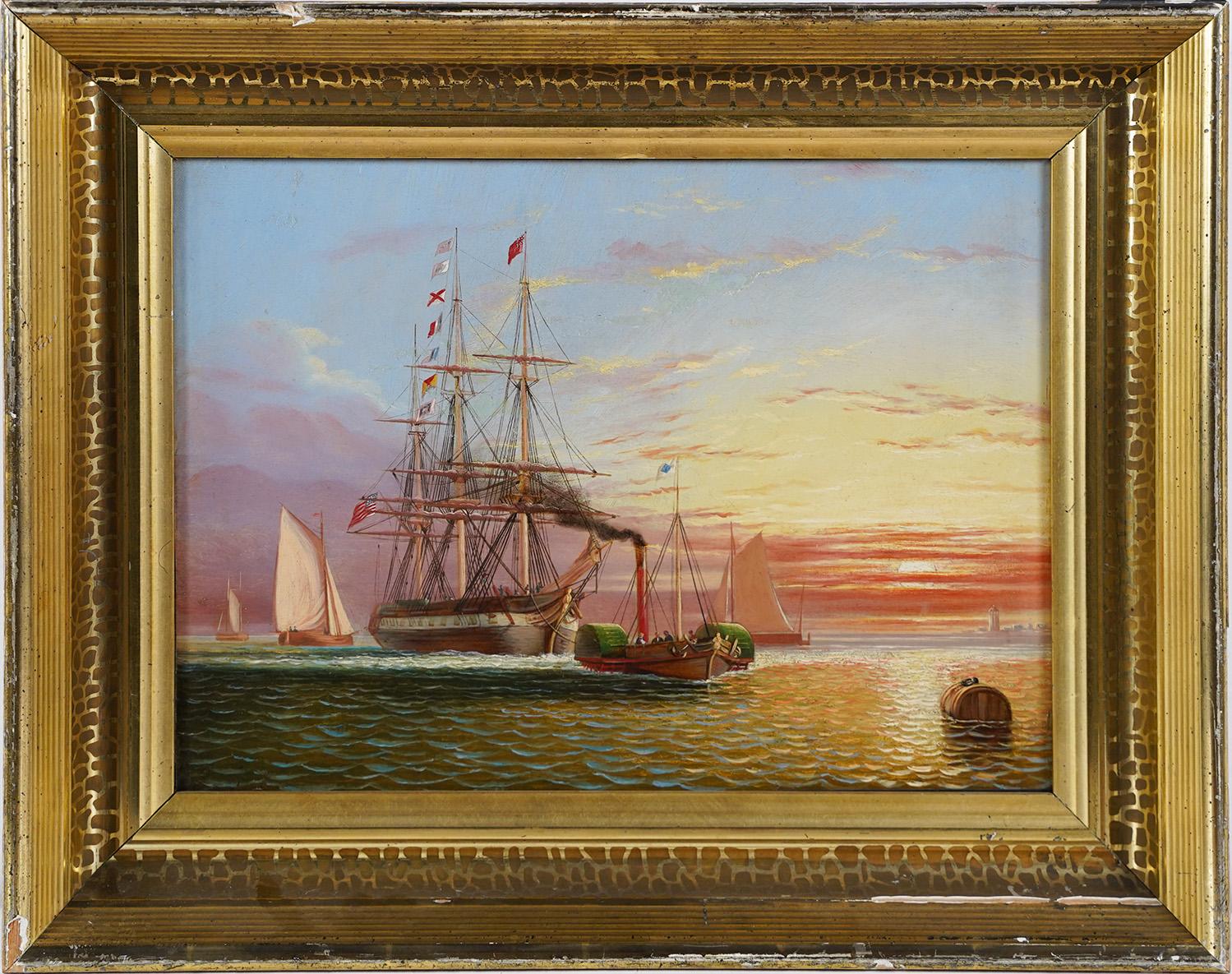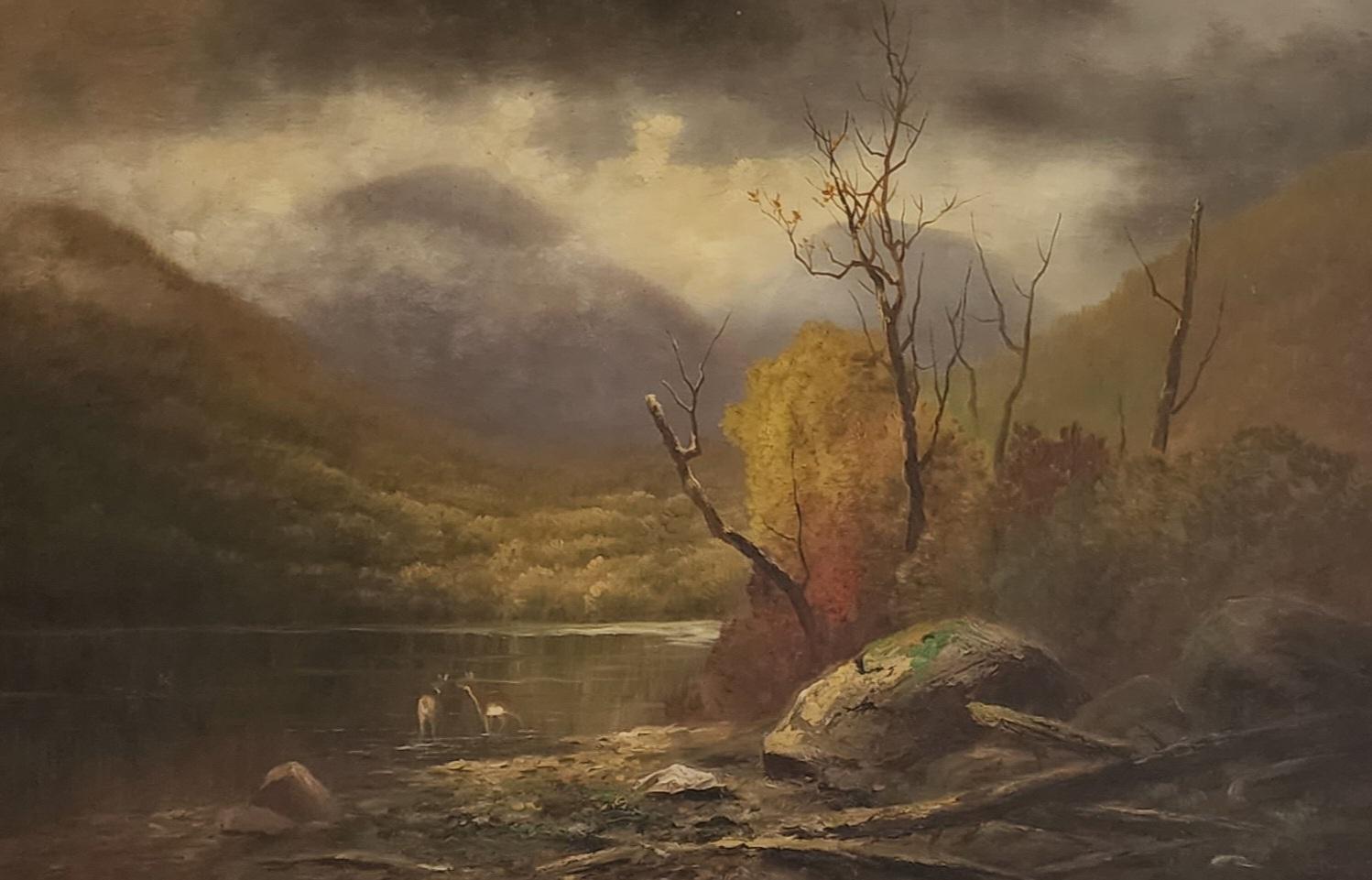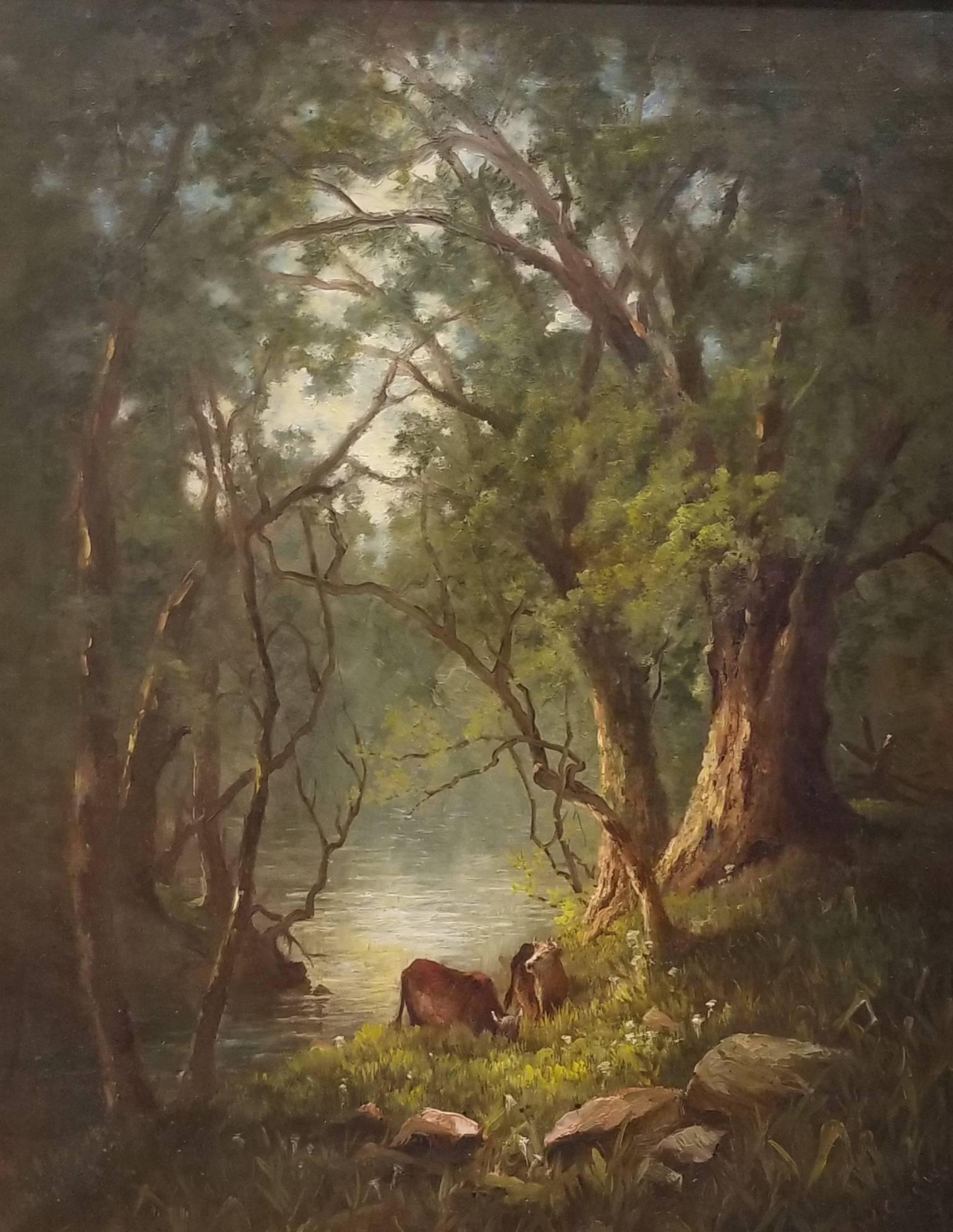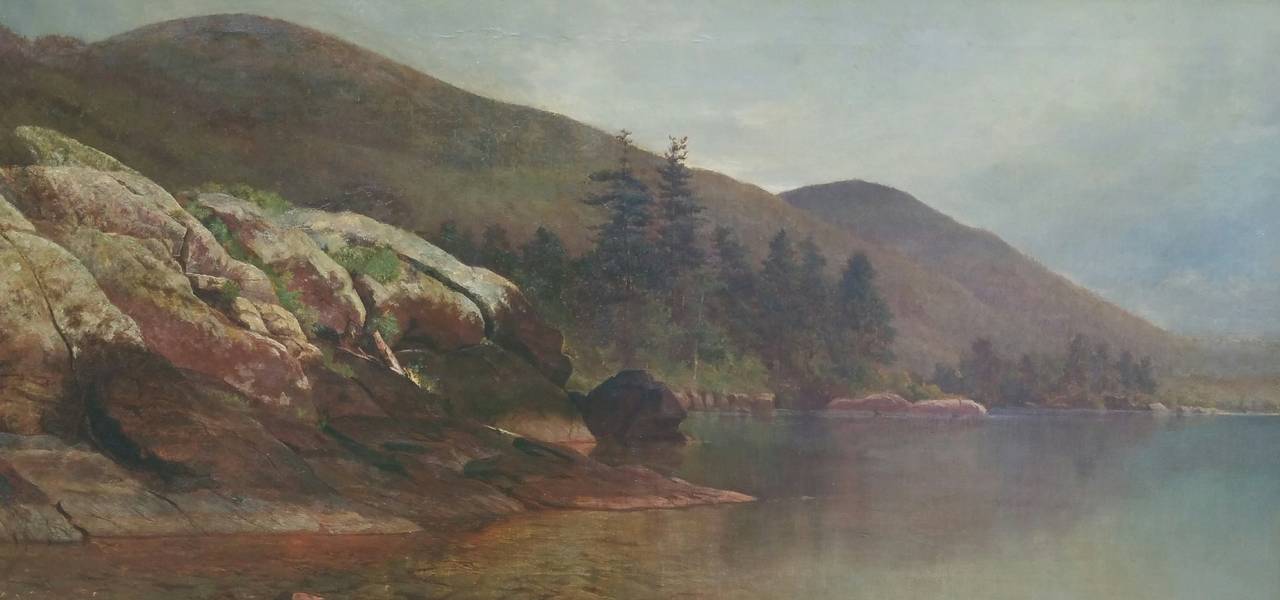Items Similar to "Building the Allegheny Railroad, Pennsylvania" Alfred Wall, Scalp Level School
Want more images or videos?
Request additional images or videos from the seller
1 of 7
Alfred S. Wall"Building the Allegheny Railroad, Pennsylvania" Alfred Wall, Scalp Level School1859
1859
About the Item
Alfred S. Wall (American, 1825-1896)
Untitled (Building the Railroad), 1859
Oil on canvas
14 1/2 x 18 1/2 inches
Signed and dated lower left
For Christmas, 2008, the Pittsburgh Post-Gazette featured Alfred Wall's painting, Old Saw Mill from the collection of the Westmoreland Museum of American Art in Greensburg, PA. It was painted in 1851 in the town of Lilly, Pennsylvania in the Allegheny Mountains. The newspaper description stated that "though the saw mill is long gone, it still conveys all the warmth and coziness of this time of year. The article, written by Patricia Lowry, continued:
At first glance, Alfred S. Wall's painting of a saw mill in snowy woods triggers nostalgia for the coziness of a log cabin, the smell of a wood-burning fire and the warming of chilled hands and feet beside it.
But as sentimental as it seems on the surface, Mr. Wall's painting has a deeper and unexpected context.
This is more than a painting about sled-riding children and early industry planted in the middle of virgin forest. Intended or not, this is a painting about conquering the great divide of the Allegheny Mountains.
For the third consecutive year, the Post-Gazette features a winter-scene painting on the cover of the Christmas Day newspaper. This year's painting, Old Saw Mill, was selected by co-publisher and editor-in-chief John Robinson Block and executive editor David Shribman during a visit to the Westmoreland Museum of American Art in Greensburg.
Mr. Wall, listed as a portrait painter in the 1850 census, was about 26 when he painted Old Saw Mill in 1851. The self-taught artist was born in Mount Pleasant, Westmoreland County, to William and Lucy Wall, who'd emigrated from England around 1820. An artistic sensibility ran in the family: William was a sculptor who carved ornate tombstones here; Alfred's children, A. Bryan and Bessie, were landscape painters, as was Alfred's older brother, William Coventry Wall. For more than a century the Walls formed a prominent art dynasty in Pittsburgh, and Alfred, eventually a partner in the city's most prestigious art gallery, was well known as a painter, dealer and restorer.
In Old Saw Mill, two wood cutters, each holding an axe, meet outside the mill; one points in the direction of the forest. On the other side of the stream, one child pulls another down the hillside on a sled. Just behind the hill's slope, the roof of a building appears, perhaps the home of the sawyer. The luminous, late afternoon light comes from the northwest, casting lengthening shadows on the snow under a darkening sky.
The saw mill in "Old Saw Mill" likely would have been impossible to track down had Mr. Wall, presumably, not written on the back of the painting: "old saw mill near Jct. 4, Portage RR, Pa."
"There was no Junction 4," said Mike Garcia, park ranger at the Allegheny Portage Railroad National Historic Site, about 90 miles east of Pittsburgh near Gallitzen, Cambria County. "But there was an Inclined Plane No. 4 at Lilly, and there was a saw mill there."
In fact, there were at least six saw mills at Lilly over the years, said longtime resident Jim Salony, president of the Lilly-Washington Historical Society. But when he saw an image of the painting, Mr. Salony had no trouble coming up with a location. While there are no known photographs of the saw mill, he believes it stood near the intersection of Portage and Washington streets, next to Bear Rock Run.
Mr. Salony, retired academic dean at Mount Aloysius College, didn't know exactly when the mill was torn down, but it's been gone since at least the late 1800s. He was pleased to learn of the painting, even though that knowledge came too late for inclusion in a new book about Lilly, The Spirit of a Community, for which he served as primary author and editor. It runs to more than 700 pages. For a little town -- population 869 last year -- Lilly has a lot of history.
Nestled in a bowl on the western slope of the Allegheny Mountains about 3 miles south of Cresson, Lilly was first settled in 1806 by Joseph Meyer and his family, who named their 332-acre land patent Dundee. Although the Meyers had left by 1811, other settlers followed, but the community didn't flourish until the 1830s, when the Allegheny Portage Railroad began its 23-year-run through the town.
For 200 years the Alleghenies had stood as an impediment to trade and travel between Pittsburgh and the east. A canal from Philadelphia to Pittsburgh would change that and compete with New York's Erie Canal. But a portage railroad would have to be built, on which teams of horses would lead the canal boats over the mountains. Engineer Sylvester Welch began his surveying from the small settlement at Lilly. The railroad would require 10 inclined planes, some quite steep, between Hollidaysburg and Johnstown. To build it, trees had to be cut along a 120-foot-wide right-of-way for 36 miles, along which track and engine houses had to be built.
William Brown, who owned the saw mill on Bear Rock Run, built at least one of the engine houses at Inclined Plane No. 4; an 1834 contract also included fencing the dwelling lots at the head and foot of the plane. Lilly is located at what was the foot of Inclined Plane No. 4., giving the community one of its early informal names, Foot of Four.
Named in 1883 for Richard Lilly, who'd completed the grist mill there, Lilly had another early name: Hemlock, so dubbed by a Portage Railroad traveler who smelled the bark stripped from the trees at the saw mill.
Because there isn't another Allegheny Portage Railroad location like it, where a cut in the mountains opens into a bowl, Mr. Salony thinks it was Lilly that Charles Dickens wrote about following his trip from Harrisburg to Pittsburgh on the Pennsylvania Canal in late March 1842, describing what he saw after emerging from "the bottom of the cut": "It was very pretty while traveling, to look down into a valley full of light and softness, catching glimpses through the tree-tops of scattered cabins; children running to the doors; dogs bursting out to bark, who we could see without hearing; terrified pigs scampering homeward; families sitting out in their rude gardens; cows gazing upward with a stupid indifference; men in their shirt-sleeves looking on at their unfinished houses, planning out to-morrow's work; and we riding onward, high above them, like a whirlwind."
To get to Lilly, Mr. Wall may have taken the Pennsylvania Canal from his home in Allegheny City, now the North Side. He'd married young, at 21, to Sarah Carr in 1846, the same year he began his career as an artist. By 1880 they were living in a brick townhouse at 104 (later 814) Arch St., now demolished.
Across the river in Pittsburgh he shared a studio at 67 Fourth Ave. with his brother William; they later moved to Burke's Building, today the city's oldest office building at 209-211 Fourth. But often they worked outdoors, sometimes as part of the colony of artists that grew up around painter George Hetzel beginning in the late 1860s at Scalp Level, just south of Johnstown.
The Walls are featured prominently in the Westmoreland Museum's current exhibit, "Scenic Views: Painters of the Scalp Level School Revisited," through Feb. 1. Scalp Level provided "all the landscape elements a painter might desire," writes museum director Judith Hansen O'Toole in her introductory essay: streams, waterfalls, forest interiors, farms, country lanes, orchards and meadows. It also provided the themes important to a 19th-century landscape painter, including man versus nature.
But the mill in Old Saw Mill, on view in the museum's lobby but not part of the Scalp Level show, seems more like a picturesque interlude in a pristine landscape than a threatening intrusion.
Last year, 29 Wall paintings were given to the museum by Betty Jane McWilliams, whose great-grandmother, Helen Wall McClure, was Alfred S. Wall's sister. While none is in the current exhibit, they'll be featured beginning Feb. 22 in a new show, "The Gift of Art," highlighting gifts to the museum.
Dr. McWilliams, University of Pittsburgh Professor Emerita, inherited some of the paintings and collected the rest, mostly through galleries, dealers and auctions in Western Pennsylvania.
"[The portraits and landscapes] were family history," Dr. McWilliams said. "I kept hearing about them and seeing them even when I was little. You can't have these people staring down at you all your life and not be interested."
Pitt published her 24-page illustrated monograph The Four Walls, drawing on her own and others' research, in 2001.
Old Saw Mill, which measures 38 inches by 57 inches, came into the collection via galleries in New York and Philadelphia. Its earlier provenance and exhibition history are unknown.
"It's of a size that it was probably done for exhibition," said Ms. O'Toole.
Mr. Salony thinks the large log across the stream at the bottom of the painting was part of temporary dams the sawyers built to hold back water for a strong release that would float the logs down Bear Rock Run.
"Always tell the truth in your work" was the artist's motto, Dr. McWilliams reports.
But truth is relative. In the lower left of the canvas, Mr. Wall winks at his audience by signing his name along the length of another log and painting the year on a nearby stone.
The Allegheny Portage Railroad was in use until 1857, when the Pennsylvania Railroad was completed. Today, near where the saw mill stood, a church and houses flank Bear Rock Run just before it flows under Portage Street, once the bed of the first railroad to cross the Alleghenies.
- Creator:Alfred S. Wall (1825 - 1896, American)
- Creation Year:1859
- Dimensions:Height: 21 in (53.34 cm)Width: 25 in (63.5 cm)
- Medium:
- Movement & Style:
- Period:
- Condition:
- Gallery Location:New York, NY
- Reference Number:1stDibs: LU1841210652602
About the Seller
5.0
Platinum Seller
These expertly vetted sellers are 1stDibs' most experienced sellers and are rated highest by our customers.
Established in 2021
1stDibs seller since 2022
60 sales on 1stDibs
Typical response time: 1 hour
- ShippingRetrieving quote...Ships From: Larchmont, NY
- Return PolicyA return for this item may be initiated within 3 days of delivery.
More From This SellerView All
- "Ship Portrait, " William Edward Norton, Seascape Maritime Painting, New EnglandBy William Edward NortonLocated in New York, NYWilliam Edward Norton (1843 - 1916) Ship Portrait, 1876 Oil on canvas 10 x 16 inches Signed and dated lower left Born in Boston, William Norton became a noted marine painter, stirred by his youth when he sailed on family-owned ships. He studied at the Lowell Institute in Boston, and with George Inness, and then established a studio in Boston. In the early 1870s, he went to Paris and became a student with Chevreuse and A. Vollon, and then he settled in London where he exhibited throughout the last quarter of the 19th century. His reputation there was based on his scenes of the Thames River, and ocean and coastal views. In 1901, he and his wife returned to the United States and settled in New York City. He also painted at Monhegan Island, Maine, where a treacherous ledge on the southern side of the island is named "Norton's Ledge" for him. He was a member of the Boston Art Club with whom he exhibited from 1873 to 1909. He also exhibited with the Pennsylvania Academy, the Royal Academy in London, the Paris Salon, the 1893 Chicago Exposition...Category
1870s Hudson River School Landscape Paintings
MaterialsOil, Canvas
- "Couple in the Field, " James Brade Sword, Hunter on Farm LandscapeBy James Brade SwordLocated in New York, NYJames Brade Sword (1839 - 1915) Couple in the Field Oil on canvas 16 x 20 inches Signed lower left After a childhood in Macao, China, James Brade Sword started out in life, after hi...Category
Late 19th Century Hudson River School Landscape Paintings
MaterialsOil, Canvas
- "Pastoral Landscape, " William Hart, Hudson River School, Cloudy View with CowsBy William HartLocated in New York, NYWilliam Hart (1823 - 1894) Pastoral Landscape, 1877 Oil on canvas 9 1/2 x 14 1/2 inches Signed and dated lower left Born in Paisley, Scotland, William Ha...Category
1870s Hudson River School Landscape Paintings
MaterialsOil, Canvas
- "A Cloudy Day, " View of Montclair, New Jersey, Tonalist, Barbizon SceneBy George InnessLocated in New York, NYGeorge Inness (1825 - 1894) A Cloudy Day, 1886 Oil on canvas 25 x 30 inches Signed and dated lower center Provenance: The artist Estate of the above Fifth Avenue Galleries, New York, Executor's Sale of Paintings by the Late George Inness, N.A., February 12 - 14, 1895, Lot 132 Joseph H. Spafford, acquired from the above Mrs. Spafford, by bequest from the above Leroy Ireland, New York, 1951 Ernest Closuit, Fort Worth, Texas Meredith Long & Company, Houston, Texas, circa 1960 Private Collection Shannon's Fine Art, American and European Fine Art Auction, October 27, 2016, Lot 42 Exhibited: New York, American Fine Arts Society, Exhibition of the Paintings Left by the Late George Inness, December 27, 1894, no. 90. Literature: LeRoy Ireland, The Works of George Inness: An Illustrated Catalogue Raisonne, Austin, Texas, 1965, p. 336, no. 1324, illustrated. Michael Quick, "George Inness: A Catalogue Raisonne," Vol. II, New Brunswick, New Jersey, 2007, pp. 282-83, 311, no. 966, illustrated. George Inness, one of America's foremost landscape painters of the late nineteenth century, was born in 1825 near Newburgh, New York. He spent most of his childhood in Newark, New Jersey. He was apprenticed to an engraving firm until 1843, when he studied art in New York with Regis Gignoux, a landscape painter from whom he learned the classical styles and techniques of the Old Masters. In 1851, sponsored by a patron, Inness made a fifteen-month trip to Italy. In 1853 he traveled to France, where he discovered Barbizon landscape painting, leading him to adopt a style that used looser, sketchier brushwork and more open compositions, emphasizing the expressive qualities of nature. After working in New York from 1854 to 1859, he moved to Medfield, Massachusetts, and four years later to New Jersey, where through a fellow painter he began to experiment with using glazes that would allow him to fill his compositions with subtle effects of light. Duncan Phillips remarked on Inness’s mellow light as a unifying force, saying, “…he was equipped to modernize the grand manner of Claude and to apply the methods of Barbizon to American subjects." At this time also, Inness developed an interest in the religious theories of Emanuel Swedenborg...Category
1880s Hudson River School Landscape Paintings
MaterialsOil, Paint, Canvas
- "Grand Manan" Harrison Bird Brown, Maine Landscape, Hudson River School SeascapeBy Harrison Bird BrownLocated in New York, NYHarrison Bird Brown (1831 - 1915) Grand Manan Oil on canvas 12 x 20 inches Signed with initials lower left Harrison Bird Brown was born in 1831 in Portland, Maine, and is best known for his White Mountain landscapes and marine paintings of Maine's Casco Bay...Category
Late 19th Century Hudson River School Landscape Paintings
MaterialsCanvas, Oil
- "Grand Manan Island Cliffs, Maine, " Marie Medora Ross, Ships at Sunset SeascapeLocated in New York, NYMarie Medora E. Ross (1844 - 1920) Grand Manan Island Cliffs, 1881 Signed Lower Left Oil on canvas 30 x 38 inches Provenance: The artist Gifted to artis...Category
1880s Hudson River School Landscape Paintings
MaterialsOil, Canvas
You May Also Like
- Delaware GapBy Régis François GignouxLocated in Milford, NHA finely detailed oil landscape of the Delaware Gap attributed to French American artist Regis Francois Gignoux (1816-1882). Gignoux was born in Lyon, France, and began his studies i...Category
Mid-19th Century Hudson River School Landscape Paintings
MaterialsCanvas, Oil
- Early Antique American School New England Sunset Sailboat Marine Oil PaintingLocated in Buffalo, NYUp for sale here is a really impressive mid 19th century painting. Very fine quality and great color! Unsigned. Framed. Image size, 13 by 17.Category
1850s Hudson River School Landscape Paintings
MaterialsOil, Canvas
- New York LandscapeLocated in Milford, NHA fine New York landscape with cows by American artist Emile Faure Beaulieu (b. 1828, actively exhibiting in the 1850-1860’s). Beaulieu was known as...Category
1850s Hudson River School Landscape Paintings
MaterialsCanvas, Oil
- AusableBy William OngleyLocated in Saratoga Springs, NYSigned lower right. A landscape and marine painter, William Ongley was born in England in 1836 and came to America with his family and settled in New York. His art studies took him ...Category
Late 19th Century Hudson River School Landscape Paintings
MaterialsOil, Canvas
- On The MohawkBy William OngleyLocated in Saratoga Springs, NYSigned lower right. A landscape and marine painter, William Ongley was born in England in 1836 and came to America with his family and settled in New York. His art studies took him ...Category
Late 19th Century Hudson River School Landscape Paintings
MaterialsOil, Canvas
- Fourteen Mile Island, Lake GeorgeBy Andrew Fisher BunnerLocated in Saratoga Springs, NYAndrew Fisher Bunner ANA 1841-1897 Andrew Fisher Bunner was born in 1841 in New York City, and he studied there and in Europe. In fact, his career included extended travels in Fra...Category
19th Century Hudson River School Landscape Paintings
MaterialsOil, Canvas
Recently Viewed
View AllMore Ways To Browse
Used Level
Antique Wall Painting
Antique Wall Paintings
Lister S
City Wall Art
Large Wall Art Paintings
Wall Art Painting Large
Framed Canvas Wall Art
Wood Level
Level Antique
Antique Level
Antique Framed Wall Art
Philadelphia School
Pennsylvania Oil
Oil Painting Pennsylvania
Wall Art Water
Book Wall Art
Pennsylvania School



